

Zitierweise / cite as:
Carakasaṃhitā: Ausgewählte Texte aus der Carakasaṃhitā / übersetzt und erläutert von Alois Payer <1944 - >. -- Anhang A: Pflanzenbeschreibungen. -- Moringa oleifera Lam. -- Fassung vom 2007-06-29. -- URL: http://www.payer.de/ayurveda/pflanzen/moringa_oleifera.htm
Erstmals publiziert: 2007-03-19
Überarbeitungen: 2007-06-29 [Ergänzungen]
Anlass: Lehrveranstaltung SS 2007
©opyright: Dieser Text steht der Allgemeinheit zur Verfügung. Eine Verwertung in Publikationen, die über übliche Zitate hinausgeht, bedarf der ausdrücklichen Genehmigung des Verfassers
Dieser Text ist Teil der Abteilung Sanskrit von Tüpfli's Global Village Library
WARNUNG: dies ist der Versuch einer
Übersetzung und Interpretation eines altindischen Textes. Es ist keine
medizinische Anleitung. Vor dem Gebrauch aller hier genannten Heilmittel wird
darum ausdrücklich gewarnt. Nur ein erfahrener, gut ausgebildeter ayurvedischer
Arzt kann Verschreibungen und Behandlungen machen!
Falls Sie die diakritischen Zeichen nicht dargestellt bekommen, installieren Sie eine Schrift mit Diakritika wie z.B. Tahoma.
Verwendete und zitierte Werke siehe: http://www.payer.de/ayurveda/caraka0001.htm
Stammpflanze von: Semen Moringae: Behennüsse; aus denen Oleum Moringae (Behenöl, Moringaöl) gewonnen wird, das als Speise- und Schmieröl verwendet wird.
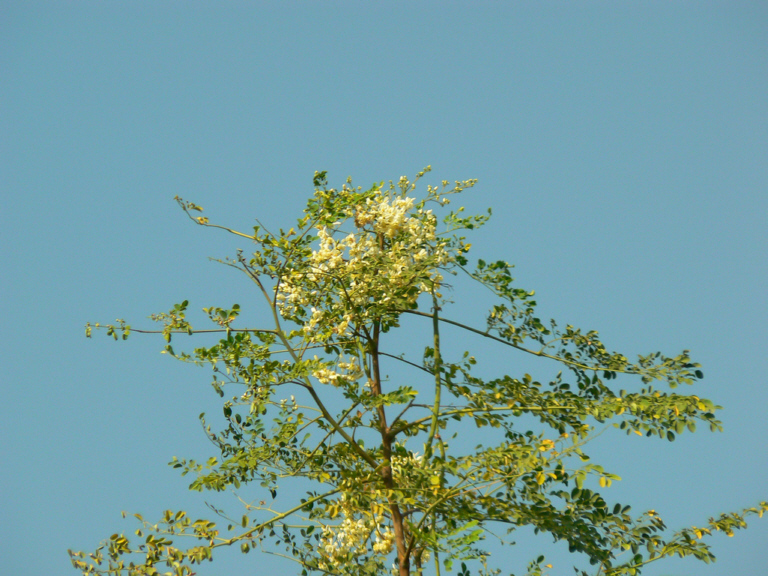
Abb.: Moringa oleifera Lam.
[Bildquelle:
dinesh_valke. --
http://www.flickr.com/photos/dinesh_valke/348694381/. -- Zugriff am
2007-06-29. --
![]()
![]()
![]() Creative
Commons Lizenz (Namensnennung, keine kommerzielle Nutzung, keine
Bearbeitung)]
Creative
Commons Lizenz (Namensnennung, keine kommerzielle Nutzung, keine
Bearbeitung)]
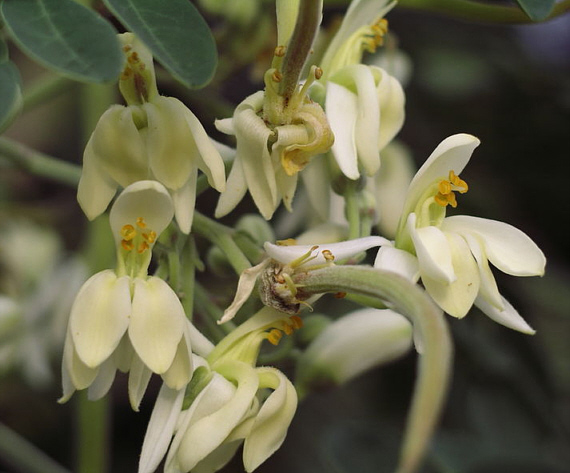
Abb.: Moringa oleifera Lam.
[Bildquelle: Wikipedia]
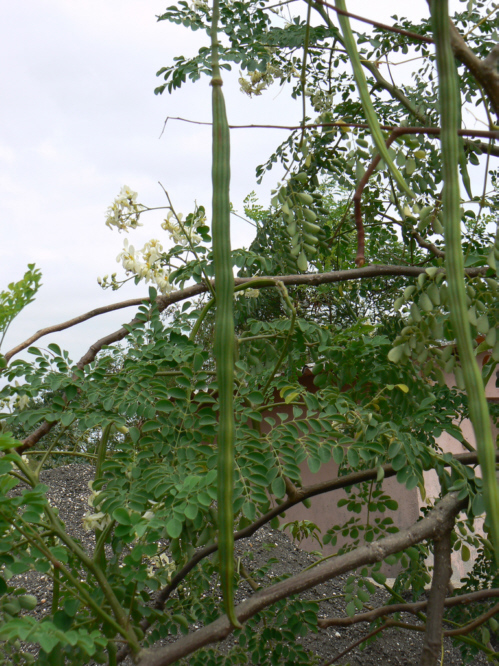
Abb.: Moringa oleifera Lam.
[Bildquelle:
dinesh_valke. --
http://www.flickr.com/photos/dinesh_valke/537119926/. -- Zugriff am
2007-06-29. --
![]()
![]()
![]() Creative
Commons Lizenz (Namensnennung, keine kommerzielle Nutzung, keine
Bearbeitung)]
Creative
Commons Lizenz (Namensnennung, keine kommerzielle Nutzung, keine
Bearbeitung)]
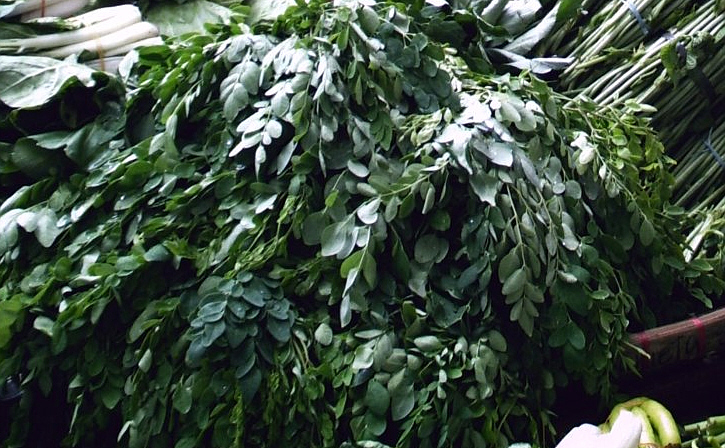
Abb.: Blätter von Moringa oleifera Lam. auf einem Markt in Baguio
City, Philippinen
[Bildquelle: Wikipedia]
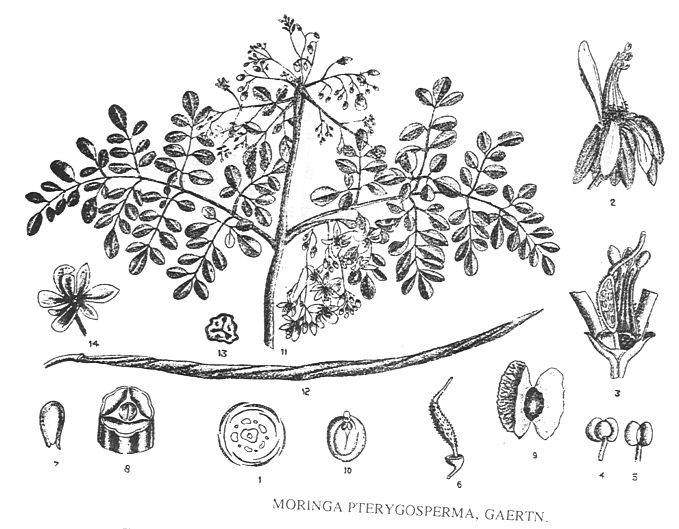
Abb.: Moringa oleifera Lam.
[Bildquelle: Kirtikar-Basu, ©1918]
Drury:
"Moringa pterygosperma (Gaertn.) N. O. Moringaceae. Horse-radish tree, Eng. Mooringhy, Tam. Mooraga, Tel. Moongay, Duk. Sujna, Hind. Shajina, Beng. Mooringeh, Mal.
Description.—Tree, 30-35 feet; leaves 2-3 pinnate with an odd leaflet; calyx 5-cleft; petals 5, nearly equal, the upper one ascending; filaments hairy at the base ; racemes panicled; 5 stamens without anthers; seeds numerous, 3-angled, the angles expanding into wings ; flowers white. Fl. Jan.—July. — W. & A. Prod. i. 176.—Guilandina Moringa, Linn. sp.— Hyperanthera Moringa, Vahl.—Roxb. Fl. Inch ii. 368.—Rheede, vi. t. 11.------Common in gardens in the Peninsula.
Medical Uses.—The native practitioners prescribe the fresh root as a stimulant in paralysis and intermittent fevers. They also use it in epilepsy and hysteria, and reckon it a valuable rubefacient in palsy and chronic rheumatism. In Java the roots have been reported beneficial in dropsy. The same virtues have been ascribed to the horse-radish of Europe, a syrup made with an infusion of which the celebrated Dr Cullen found efficacious in removing hoarseness. The root has a pungent odour and a heavy aromatic taste. Dr Wight suggested that it would greatly increase the activity of sinapisms. An oil is prepared from the seeds which is used externally for pains in the limbs, gout, and rheumatism. In the West Indies it is used as a salad oil, because it does not congeal or turn rancid. The leaves, bark, and root, according to Rheede, are antispasmodic. The juice of the leaves mixed with pepper is applied over the eyes in vertigo; and mixed with common salt is given to children in flatulency. It is also used to hasten suppuration in boils. The bark, rubbed up in rice-water mixed with cumin-seed, is a cure for gumboils and toothache. The leaves simply warmed are applied in hydrocele, and also good for ulcers and guinea-worm. A gum resembling tragacanth exudes from this tree if an incision be made in the bark. It is used, in headache, mixed with milk and externally rubbed on the temples. It is also locally applied to buboes and venereal pains in the limbs. In Jamaica the wood is employed for dyeing a blue colour.—Ainslie. Rheede.
Economic Uses.—The root of this tree is much like the English horse-radish. The long legumes are well known as a vegetable so often used both by Europeans and natives in curries. The seeds were formerly known as the Ben nuts, from which the oil of Ben was extracted. It is chiefly used by perfumers and watchmakers. Both leaves and flowers are eaten by the natives.—Wight. Lindley."
[Quelle: Drury, Heber <1819 - 1872>: The useful plants of India : with notices of their chief value in commerce, medicine, and the arts. -- 2d ed. with additions and corrections. London : Allen, 1873. -- xvi, 512 p. ; 22 cm. -- s.v.]
Dutt:
"MORINGA PTERYGOSPERMA. Sans. Śobhāñjana. Śigru.
This plant is cultivated all over the country for the sake of it's leaves, flowers, and seed vessels which are used by the natives in their curries. The root is described as acrid, pungent, stimulant and diuretic, Applied externally it acts as a rubefacient. The seeds are described as acrid and pungent and are used externally as a stimulant. They are called Sveta maricha that is white pepper. The Bhāvaprakāśa describes two varieties of śobhāñjana, namely, white and red. The root of the white variety is said to be a stronger rubefacient, while that of the red, is preferred for internal use, for promoting the appetite and acting on the excretions.
In ascites and enlarged spleen, a decoction of the root-bark of Moringa pterygosperma and the leaves of Rumex vesicarius (amlalonikā) is given with the addition of long pepper, black pepper and rock salt in powder. In enlarged spleen and liver, a decoction of the root-bark is recommended to be given with the addition of plumbago root, rock salt and long pepper, or of the ashes of Butea frondosa (palāsa), or of yavakshāra (impure carbonate of potash).
In internal and deep seated inflammation and abscess (vidradhi) a decoction of the root-bark is recommended to be given with the addition of asafoetida and rock salt. The expressed juice of the root-bark is also given in these cases, with the addition of honey or rock salt, The root-bark is used externally in the shape of plaster, and the inflamed part is fomented with its decoction.
In calculous affections the decoction of the root-bark is given internally.
The seeds of Moringa pterygosperma enter into the composition of some stimulant applications. The following is an illustration. Take of the seeds of Moringa pterygosperma, rock salt, mustard seeds and putchuk root, equal parts, and reduce them to a paste with goat's urine. When dried this is used as a snuff for rousing comatose or drowsy persons. The fresh juice of the root bark is recommended to be poured into the ears, for the relief of otalgia. The gum of the tree mixed with sesamum oil, is also used for the same purpose."
[Quelle: Dutt, Uday Chand: The materia medica of the Hindus / Uday Chand Dutt. With a glossary of Indian plants by George King. -- 2. ed. with additions and alterations / by Binod Lall Sen & Ashutosh Sen. -- Calcutta, 1900. - XVIII, 356 S. -- S. 117 - 119.]